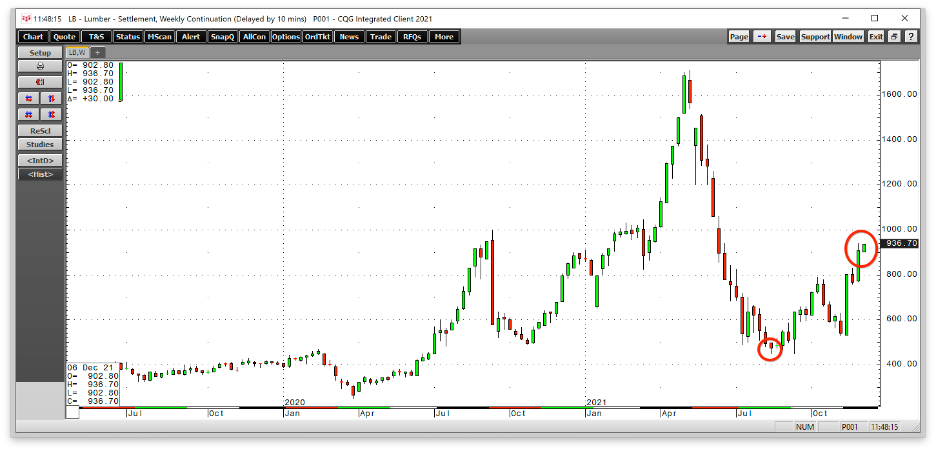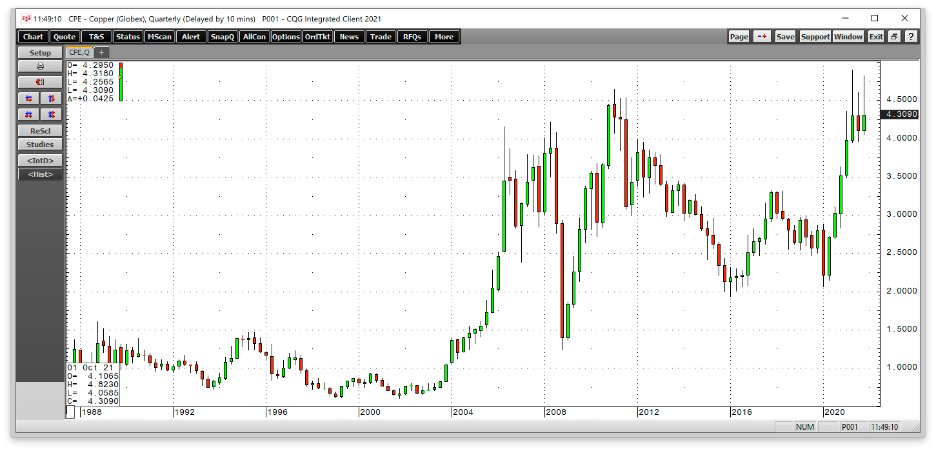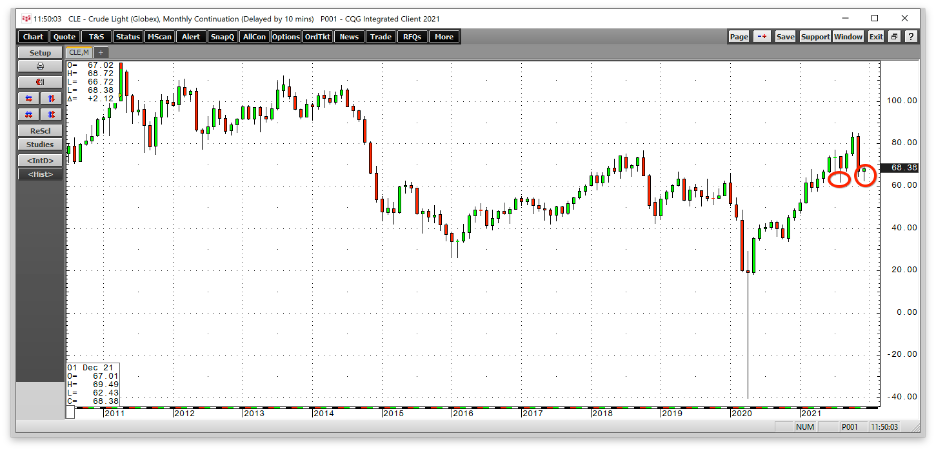This article was written exclusively for Investing.com
- New highs in the dollar index
- The prospects for rising US interest rates are bullish for the US currency
- Commodities have been rallying since the 2020 lows
- The first two reasons for higher prices: Inflation and logistics
- The second two reasons: Decarbonization and pricing power
The last secular bull market in the commodities asset class began when prices fell to lows in 2008 as the global financial crisis gripped markets across all asset classes. Central banks and governments dug deep into monetary and fiscal toolboxes to stabilize local and worldwide economic conditions. Slashing short-term interest rates, purchasing longer-term debt via quantitative easing programs, and stimulus packages provided the stability that got the economy through the US housing and mortgage-backed securities debacle and the European sovereign debt crisis.
One of the side effects of the treatments was a bull market in commodities that lifted prices to multi-year and, in some cases, all-time highs by 2011 and 2012.
In 2020, the worldwide COVID-19 pandemic was an entirely different crisis, but the central banks and government employed the same monetary and fiscal tools. The only difference was the levels required were far higher in 2020 than a dozen years before. The policies ignited a bullish fuse in commodities in 2020 and 2021. The legacy of unprecedented levels of liquidity and stimulus could mean the virus’s legacy will continue to push prices higher for years to come.
Even though the US Federal Reserve has begun to address rising inflationary pressures, the damage is already done. The central bank is behind the curve, with the latest CPI data at the highest level in three decades.
Bull markets rarely move in straight lines; commodity volatility makes periodic corrections downright nasty. However, we should expect higher lows and higher highs in the raw material market over the coming years as the price tag for the pandemic is massive.
New highs in the dollar index
The US dollar remains the world’s reserve currency. Even though China’s economy is nipping at the US’s heels to overtake the leadership position, a reserve currency must be freely convertible. Restrictions on the Chinese yuan have made the foreign exchange instrument exempt from reserve status. The second-leading reserve currency is the euro. The Japanese yen, British pound, and other currencies also have reserve status, but the US dollar is the top dog in the world of fiat foreign exchange instruments.
Over the past weeks and months, and throughout 2021, the dollar index, which measures the US currency against other world reserve foreign exchange instruments, has been moving higher.

Source: CQG
As the chart highlights, the dollar index reached its low for 2021 in early January at 89.165 on the continuous futures contract. Since then, the index has made higher lows and higher highs. The most recent peak was at 96.940 in late November, the highest level since July 2020.
The prospects for rising US interest rates are bullish for the US currency
Many factors determine the value of one currency versus another, but interest rate differentials play a significant role in whether currencies gain or lose value against each other. With the US Fed now tapering its QE program, the first step towards liftoff from a zero percent Fed Funds rate, US interest rates will increase over the coming year. A more hawkish approach to monetary policy to combat rising inflationary pressures could accelerate the process.
Since the dollar index is weighted towards the euro, with a 57.6% exposure, interest rate differentials between the US and European currencies play the primary role in establishing the exchange rate and the dollar index’s value. Economic data from the US suggests more rapid growth than in Europe, suggesting a widening gap between US and European interest rates, supporting the dollar and pushing the dollar index higher. The trend in the dollar index has been bullish since the low from the week of Jan. 4, 2021, and that path of least resistance looks set to continue into 2022.
Commodities have been rallying since the 2020 lows
Similar monetary and fiscal policy tools in 2020 compared to 2008 provided liquidity and stimulus to the financial system during troubled times. However, the pandemic required far higher levels. From 2008 through 2012, commodity prices experienced a secular bull market that took prices to multi-year, and in some cases, all-time highs.
In 2020, the first commodity to show signs that rising inflationary pressures would translate to higher prices was the gold market. Gold had already risen to new record highs in many currencies in 2019. In August 2020, the price eclipsed the $2,000 level in US dollar terms for the first time. In 2021, many other commodities followed in a bullish relay race, with one market handing the bullish baton to the next. Gold corrected, but in February 2021, silver reached over $30 per pound for the first time since 2013 before selling pushed the price lower.
Meanwhile, agricultural commodity prices rose to multi-year highs, and energy prices climbed. In May 2021, lumber, copper, and palladium moved to new record levels when gravity caused price corrections. In November 2021, coffee and wheat futures reached multi-year highs. In early December, coffee moved to an even higher high at over the $2.50 per pound level. Meanwhile, until the recent selloff in stocks and cryptocurrencies, they reached record highs.
The legacy of the 2020 global pandemic will impact markets for the coming years. The liquidity and stimulus have long-lasting and far-reaching impacts on markets across all asset classes. Since the US dollar is the world’s reserve currency and the benchmark for commodity prices worldwide, a rising dollar tends to weigh on raw material prices. However, we could see a departure from that relationship over the coming months and years for four reasons.
The first two reasons for higher prices: Inflation and logistics
The currency markets are a mirage as they measure the value of one foreign exchange instrument versus others. Therefore, when the value of all fiat currencies, including the US dollar, falls, it is not readily apparent by watching foreign exchange relationships. Rising inflation erodes money’s purchasing power.
The global response to COVID-19 creates a unique situation where fiat currencies are losing value. The dollar index could continue to rise over the coming months and years, with commodity prices continuing to trend higher as the bullish relay race continues. Last week, in a sign that inflation continues to impact the market despite a pivot by the US Fed to a more hawkish monetary policy approach, the illiquid lumber market quietly moved back over $900 per 1,000 board feet.
Source: CQG
The chart highlights lumber’s rise from $448 in August 2021 to over double that level on Dec. 6. Lumber is a highly illiquid futures market, but it is often a precursor of price action in other raw material markets.
Logistics is another factor that contributes to rising commodity prices despite a rising dollar. Bottlenecks in worldwide supply chains will continue into 2022 and beyond. While vaccine rates in the US and Europe have been climbing, the same does not hold for other areas in the world. Commodity production occurs in regions where the earth is rich in reserves and the soil and climate support crop growth. Many producing countries continue to experience COVID-19 slowdowns or shutdowns, impacting the supply chain.
The second two reasons: Decarbonization and pricing power
The US administration and other countries worldwide are addressing climate change, requiring a shift from fossil fuel energy to renewable and alternative sources. The greener path for energy creates two significant issues that put upward pressure on commodity prices.
Copper is a nonferrous metal that is an infrastructure building block and a barometer for the health and wellbeing of the global economy. Copper’s price tends to rise during global economic growth and fall when the economy contracts. In May 2021, copper reached a new all-time high at nearly $4.90 per pound before correcting. The red metal was sitting near the $4.30 level at the beginning of this week.
Source: CQG
The quarterly chart shows the bullish price action of higher lows and higher highs in the copper futures market since 2001, when it reached a low of 60.50 cents per pound. Goldman Sachs’s analysts project that copper’s price is heading much higher over the coming years, with a price target of $15,000 per ton by 2025. At that level, nearby COMEX futures would rise to over $6.80 per pound.
According to Goldman Sachs:
“Copper is the new oil, and decarbonization does not happen without copper.”
Copper and many other metals and minerals that are battery requirements will see demand growth. Bringing new mining projects to production takes almost a decade, meaning supply-demand deficits are on the horizon. The demand boom only exacerbates the potential for higher prices in an inflationary environment, creating nearly a perfect bullish storm.
Meanwhile, the Biden administration has encouraged alternative energy sources while inhibiting domestic oil, gas, and coal production. In March 2020, US crude oil output reached a record 13.1 million barrels per day. For the week ending on Nov. 26, it was 11.5% lower at 11.6 mbpd. The administration canceled the Keystone XL pipeline, banned drilling and fracking for oil and gas on federal lands in Alaska, and is moving to curtail other pipelines posing environmental threats.
Meanwhile, fossil fuels continue to power the world, including the US. China and India, the world’s two most populous countries, continue to consume more oil, gas, and coal each day. In the US, only around 1% of cars on the road run on electric power; the rest operate on petroleum products. It will take decades to switch to other fuel sources.
The shift to a greener path and sudden change in US energy policy in 2021 hands the pricing power back to OPEC, the international oil cartel, and Russia. After spending decades to achieve energy independence, the US has surrendered control over short-term prices back to decisions made in Riyadh, Saudi Arabia, and Moscow, Russia.
The cartel’s mission is to provide the highest possible petroleum price for its members while balancing supply and demand. A decline in US production pushes the equation towards more demand and fewer supplies. As of the week ending on Nov. 26, 2021, US crude oil and oil product inventories have declined in 2021, according to the Energy Information Administration and the American Petroleum Institute:
- Crude oil - The EIA reports a 60.20-million-barrel decline - The API shows they dropped by 52.375 million barrels
- Gasoline - The EIA shows a 20.80-million-barrel decline - The API reports a 1.4079 mb drop
- Distillates - The EIA’s data reveals a 28.10-million-barrel decrease - The API 22.473 mb drop
The bottom line is US oil and oil product stocks, and production has declined under the Biden administration at a time when energy demand has been booming. While crude oil prices corrected over the past weeks, the medium-term trend remains bullish during the seasonally weak winter months. 
Source: CQG
The monthly chart illustrates that while nearby NYMEX crude oil futures fell to $62.43 per barrel last week at the low. The energy commodity did not yet violate the August 2021 $61.74 low, keeping the trend of higher lows intact since crude oil reached a bottom in April 2020 when the price briefly fell to negative territory.
The trend in the US dollar index is higher, and rising US rates over the coming months and years could propel the US currency higher against other foreign exchange requirements. The legacy of the global pandemic and a new energy policy path in the US could mean that the secular bull market in commodities continues, even as the dollar rises. I remain bullish on commodity prices despite the recent weakness in the asset class and expect the bullish relay race to higher highs to continue.
